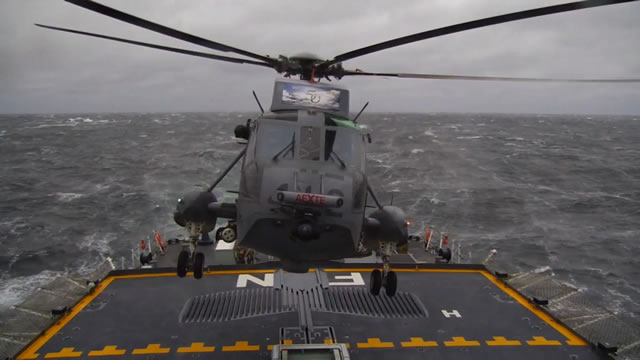Breaking news
DRDC technology supports safer and smoother landings at sea for the Royal Canadian Navy.
| 2014
 A CH-124 Sea King helicopter attempts to land on HMCS FREDERICTON during Ship Helicopter Operation Limits (SHOL) trials. |
|||
“Wind
speed, ship motion, and sea states all affect helicopter landings at sea,”
says T. J. Caron, Ship Modification Lead Engineer, Project Management
Office (PMO), Maritime Helicopter Project (MHP), Department of National
Defence (DND). “The unique capability of the DRDC Flight Deck Motion
System (FDMS) to measure and predict ship and wave motions and present
a complete picture to the operator is a valuable tool in ensuring safer
operation of maritime helicopters and RCN ships and reducing the risk
to Canadian Armed Forces (CAF) members during takeoff and landing.” “FDMS is an excellent example of our ability to contribute to the technological and operational effectiveness of the RCN”, says DRDC Director General Science and Technology Air and Navy, Dale Reding. “Science and technology (S&T) support to CAF operations is a priority for DRDC.” |
|||
|
A CH-124 Sea King helicopter attempts to land on HMCS FREDERICTON during
Ship Helicopter Operation Limits (SHOL) trials. |
|||
The FDMS
was originally developed to assist with CH-148 Cyclone Ship Helicopter
Operation Limits (SHOL) trials. Most recently, the FDMS played a role
in the re-certification of Canada’s CH-124 Sea King helicopters
for operations on the twelve newly refitted Halifax-class patrol frigates.
Part of the Frigate Life Extension (FELEX) program, the refit resulted
in changes to the frigate superstructure, the part of the ship that is
above the main deck. The changes had the potential to impact the wind
flow over the flight deck, alter the ships’ previously known air-wake,
and increase the risks of flying in close proximity to the ship. To ensure the superstructure modifications would not impact helicopter operations, the National Research Council (NRC) tested the impact of the changes on wind flow under controlled conditions at their wind tunnel testing facilities. In addition, the Royal Canadian Air Force (RCAF) tasked the Aerospace Engineering Test Establishment (AETE) with redefining Sea King ship-helicopter operating limits. During Sea King flight tests, AETE partnered with DRDC and the NRC to conduct a sea trial, during uncontrolled conditions, using the FDMS on Her Majesty’s Canadian Ship (HMCS) FREDERICTON. During the trial, the system fully illustrated the effect of the complex sea conditions on ship motion, displayed the constantly shifting flight deck motions relative to pre-defined limits and enabled the identification of safe recovery course and speed in the event of an in-flight emergency. “The FDMS presents ship and flight crews with an integrated display of live-streaming ship and environmental data and real-time guidance, resulting in greater situational awareness and improved safety, with the potential to expand helicopter operating parameters,” says Major Dany Duval of AETE. “This unique capability creates a higher level of situational awareness for operators and will directly contribute to expanding ship-helicopter operational limits while enhancing safety.” DRDC will continue to work with the MHP Project Management Office to support the potential commercialization of the FDMS and help ensure that it is available to install on RCN ships in the future. |
|||


























